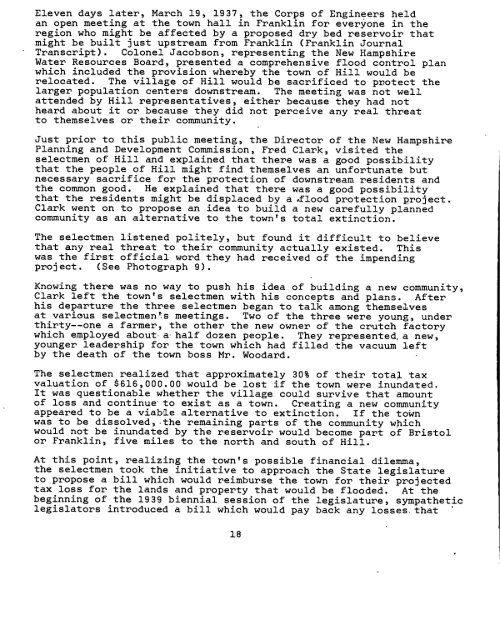; SP- IWR° CONTRACT REPORT 78-4... , UNDER ... - IWR - U.S. Army
; SP- IWR° CONTRACT REPORT 78-4... , UNDER ... - IWR - U.S. Army
; SP- IWR° CONTRACT REPORT 78-4... , UNDER ... - IWR - U.S. Army
Create successful ePaper yourself
Turn your PDF publications into a flip-book with our unique Google optimized e-Paper software.
Eleven days later, March 19, 1937, the Corps of Engineers held<br />
an open meeting at the town hall in Franklin for everyone in the<br />
region who might be affected by a proposed dry bed reservoir that<br />
might be built just upstream from Franklin (Franklin Journal<br />
' Transcript). Colonel Jacobson, representing the New Hampshire<br />
Water Resources Board, presented a comprehensive flood control plan<br />
which included the provision whereby the town of Hill would be<br />
relocated. The village of Hill would be sacrificed to protect the<br />
larger population centers downstream. The meeting was not well<br />
attended by Hill representatives, either because they had not<br />
heard about it or because they did not perceive any real threat<br />
to themselves or their community. _<br />
Just prior to this public meeting, the Director of the New Hampshire<br />
Planning and Development Commission, Fred Clark, visited the<br />
selectmen of Hill and explained that there was a good possibility<br />
that the people of Hill might find themselves an unfortunate but<br />
necessary sacrifice for the protection of downstream residents and<br />
the common good. He explained that there was a good possibility<br />
that the residents might be displaced by a .flood protection project.<br />
Clark went on to propose an idea to build a new carefully planned<br />
community as an alternative to the town's total extinction.<br />
The selectmen listened politely, but found it difficult to believe<br />
that any real threat to their community actually existed. This<br />
was the first official word they had received of the impending<br />
project. (See Photograph 9).<br />
Knowing there was no way to push his idea of building a new community,<br />
Clark left the town's selectmen with his concepts and plans. After<br />
his departure the three selectmen began to talk among themselves<br />
at various selectment:s meetings. Two of the three were young, under<br />
thirty--one a farmer, the other the new owner of the crutch factory<br />
which employed about a half dozen people. They represented, a new,<br />
younger leadership for the town which had filled the vacuum left<br />
by the death of the town boss Mr. Woodard.<br />
The selectmen realized that approximately 30% of their total tax<br />
valuation of $616,000.00 would be lost if the town were inundated.<br />
It was questionable whether the village could survive that amount<br />
of loss and continue to exist as a town. Creating a new community<br />
appeared to be a viable alternative to extinction. If the town<br />
was to be dissolved, the remaining parts of the community which<br />
would not be inundated by the reservoir would become part of Bristol<br />
or Franklin, five miles to the north and south of Hill.<br />
At this point, realizing the town's possible financial dilemma,<br />
the selectmen took the initiative to approach the State legislature<br />
to propose a bill which would reimburse the town for their projected<br />
tax loss for the lands and property that would be flooded. At the<br />
beginning of the 1939 biennial session of the legislature, sympathetic<br />
legislators introduced a bill which would pay back any losses, that '<br />
18







